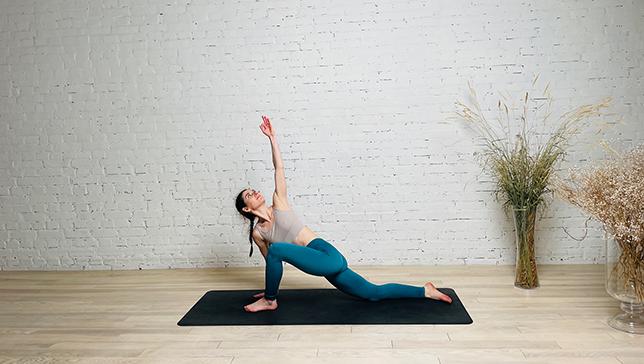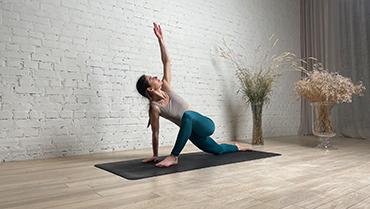Low Lunge Twist - Parivrtta Anjaneyasana

Contents
Low Lunge Twist, revolved Low Lunge or Parivrtta Anjaneyasana (PAHR-ee-VREE-tah AHN-jah-nay-AHS-uh-nuh) is an intermediate standing twist that calms the mind and lengthens the spine. The name comes from the Sanskrit, parivrtta, meaning “revolved”; anjaneya, meaning “salutation” or “praise”; and asana, meaning “posture” or “pose.”
In this pose, the yogi begins in a low lunge position with the hands in prayer position at the heart center. The torso then twists toward the lead leg, placing the opposite upper arm on the thigh while holding prayer position. The chest twists toward the sky and the gaze is upward over the shoulder.
Pose Detail
- By Type: Balancing Yoga Poses, Strengthening Yoga Poses
- Difficulty: Beginners
- Body Position: Forward Bend Yoga Poses, Standing Yoga Poses, Twist Yoga Poses
Step-by-Step Instructions
Benefits and Contraindications
Develops stamina
Relieves sciatica pain
Stretches the psoas and hips
Stimulates abdominal organs
Strengthens the quadriceps and gluteus muscles
Improves balance, concentration, and core awareness
Hips, knees, or lower back injuries
High or low blood pressure
Spinal injuries
Photo poses in different angles

Modifications and Props for Beginners
- If you have knee sensitivity, you can place a folded blanket or towel under your back knee to cushion it. You can also practice the pose with your back knee lifted off the ground.
- If you find it difficult to balance in the pose, you can use two yoga blocks to support your hands. Place the blocks on either side of your front foot and rest your hands on them as you twist.
- If you are having difficulty maintaining your balance, you can practice the pose with your back against a wall. This will help you feel more stable and grounded in the pose.
- If you have limited mobility in your shoulders, you can use a yoga strap to help you twist more deeply. Hold the strap with both hands and draw your shoulder blades together as you twist.
Useful Tips
- Your gaze should follow the twist of your torso. Look over your shoulder as you twist, and keep your gaze soft and relaxed.
- To protect your lower back, engage your core muscles as you twist. This will help you maintain stability and prevent any strain on your lower back.
- As with any yoga pose, it’s important to listen to your body and move slowly and mindfully. Don’t force yourself into the pose or push beyond your limits. Instead, breathe deeply and allow your body to open naturally over time.
Frequently Asked Questions
The frequency of your Parivrtta Anjaneyasana practice will depend on your individual needs and goals, as well as your level of experience and comfort with the pose. It can be incorporated into a daily or weekly yoga practice, or used as a warm-up or cool-down for other physical activities. It’s important to listen to your body and practice in a way that feels safe and sustainable for you.